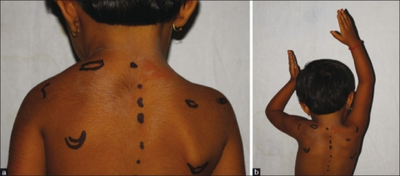Sprengel's deformity
| Sprengel's deformity | |
|---|---|
| Other names: Sprengel deformity, Sprengel's shoulder, Sprengel shoulder, high scapula | |
 | |
| Sprengel's deformity, showing a higher right-sided shoulder blade | |
| Types | Muscular forms |
Sprengel's deformity (also known as high scapula or congenital high scapula) is a rare congenital skeletal abnormality where a person has one shoulder blade that sits higher on the back than the other. The deformity is due to a failure in early fetal development where the shoulder fails to descend properly from the neck to its final position. The deformity is commonly associated with other conditions, most notably Klippel–Feil syndrome, congenital scoliosis, including cervical scoliosis, fused ribs, the presence of an omovertebral bone (an extra bone between the scapula and a cervical vertebra) and spina bifida. The left shoulder is the most commonly affected shoulder, but the condition can be bilateral, meaning that both shoulders are affected.
About 75% of all observed cases are girls. Treatment includes surgery in early childhood and physical therapy. Surgical treatment in adulthood is complicated by the risk of nerve damage when removing the omovertebral bone and when stretching the muscle tissue during relocation of the shoulder.
Signs and symptoms
The scapula is small and rotated so that its inferior edge points toward the spine. Sometimes a bony connection is present between the elevated scapula and one of the cervical vertebrae, usually C5 or C6. This connection is known as an omovertebral bone.[citation needed]
There is a high correlation between Sprengel's deformity and Klippel–Feil syndrome.[citation needed]
-
a) Marked elevation of left scapula b)restriction of abduction
-
CT scan showing Sprengel's deformity of the left side (arrow) and fused cervical vertebrae, as seen in Klippel–Feil syndrome
Cause

The exact reason for this condition is not understood, though on rare occasions it does occur via inheritance, in an autosomal dominant manner[1]
Diagnosis
Diagnosis is clinical and can be confirmed by instrumental diagnostics like conventional radiography and CT scan. It may be indicated to perform a genetic analysis, as the deformity may occur under other conditions (see Klippel–Feil syndrome).
Treatment
The management of this condition is based on degree of functional impairment.Some individuals may have physical therapy to manage the condition, while others need surgery ( to release the binding of and relocate the scapula) [2]
Eponym
It is named for German surgeon Otto Sprengel, who described it in 1891.[3][4]
References
- ↑ "Sprengel Deformity". NORD (National Organization for Rare Disorders). Archived from the original on 23 March 2021. Retrieved 9 December 2021.
- ↑ "Sprengel deformity | Genetic and Rare Diseases Information Center (GARD) – an NCATS Program". rarediseases.info.nih.gov. Archived from the original on 18 March 2021. Retrieved 9 December 2021.
- ↑ synd/2450 at Who Named It?
- ↑ O. K. Sprengel. Die angeborene Verschiebung des Schulterblattes nach oben. Archiv für klinische Chirurgie, Berlin, 1891, 42: 545-549.
External links
| Classification | |
|---|---|
| External resources |

